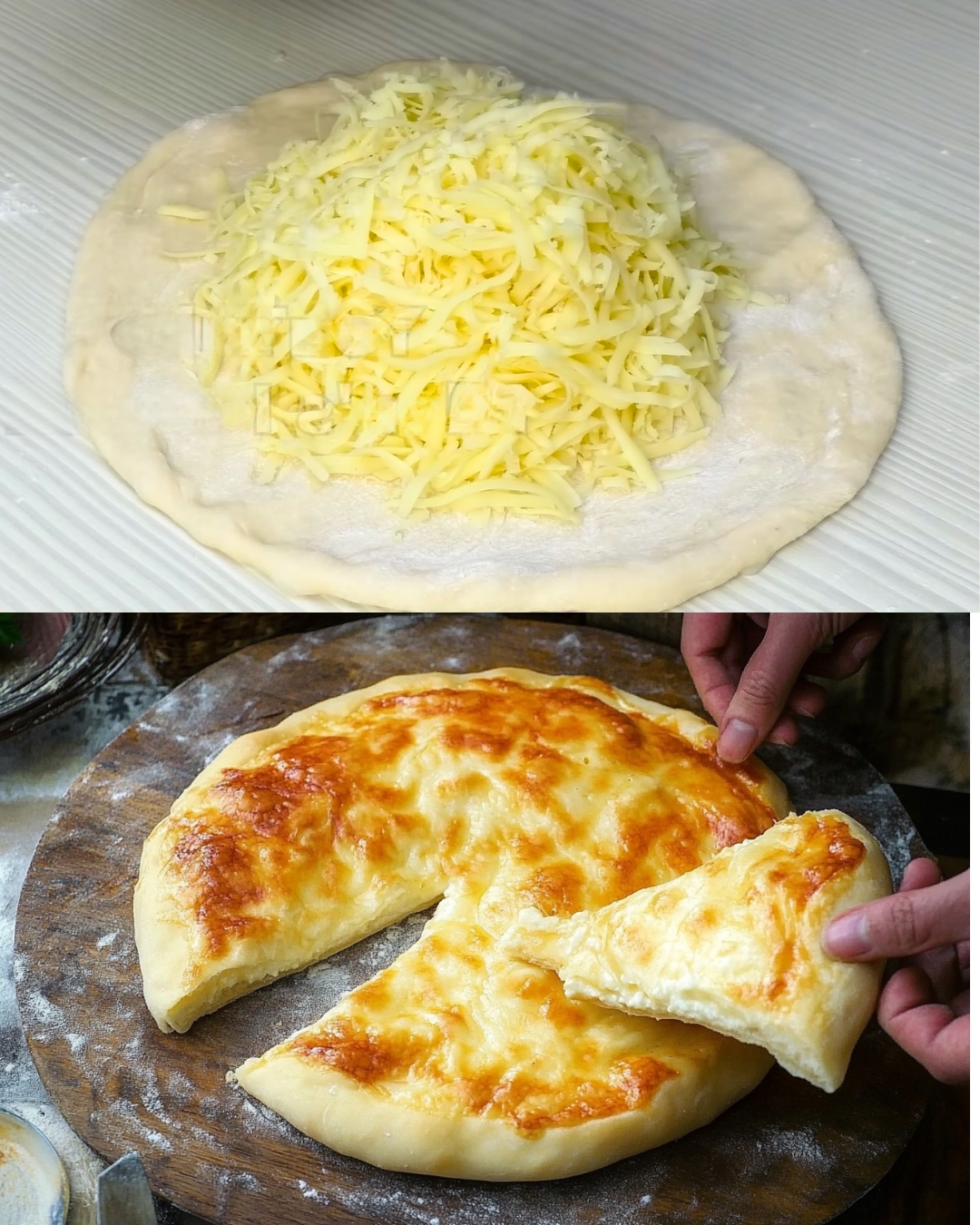Khachapuri, a traditional Georgian cheese-filled bread, is a culinary masterpiece. This recipe focuses on the Imeruli style, known for its round shape and cheese filling. It’s a delightful combination of soft, slightly chewy dough and a generous amount of melted, gooey cheese.
Preparation time: 30 minutes (plus 1-2 hours for rising)
Ingredients:
- For the Dough:
- 100 ml warm water (105-115°F/40-46°C)
- 100 ml warm milk (105-115°F/40-46°C)
- ½ tsp salt
- 1 tbsp sugar
- 1 large egg
- 4 g active dry yeast (or 1 ½ tsp instant yeast)
- 300 g all-purpose flour, plus more for dusting
- 4 tbsp vegetable oil
- For the Filling:
- 450 g Suluguni cheese, grated (or a mix of mozzarella and feta)
- For the Egg Wash:
- 1 egg yolk
- 1 tbsp milk
Directions:
-
Activate the Yeast: In a large bowl, combine the warm water, warm milk, sugar, and yeast. Gently whisk and let it sit for 5-10 minutes until foamy. This indicates the yeast is active.
-
Mix the Dough: Add the egg, salt, and vegetable oil to the yeast mixture. Whisk to combine. Gradually add the flour, mixing with a wooden spoon or your hands until a shaggy dough forms.
-
Knead the Dough: Turn the dough out onto a lightly floured surface. Knead for 8-10 minutes, until it becomes smooth, elastic, and no longer sticky. If the dough is too sticky, add a little more flour, one tablespoon at a time.
-
First Rise: Lightly oil a bowl. Place the dough in the bowl, turning to coat. Cover the bowl with plastic wrap or a clean kitchen towel and let it rise in a warm place for 1-2 hours, or until doubled in size.
-
Prepare the Filling: While the dough is rising, grate the Suluguni cheese. If you can’t find Suluguni, you can substitute a mix of mozzarella and crumbled feta cheese for a similar flavor.
-
Shape the Khachapuri: Once the dough has doubled, punch it down gently to release air. Divide the dough into two equal portions.
-
Form the Cheese Boats: On a lightly floured surface, roll out each portion of dough into a circle about 8-10 inches in diameter.
-
Fill with Cheese: Place half of the grated cheese in the center of each dough circle, leaving a 1-inch border.
-
Seal and Shape: Gently pull the edges of the dough circle towards the center, pinching them together to seal the filling. You should now have a round, cheese-filled bun. Gently flip the bun over so the seam is on the bottom.
-
Flatten and Bake: Gently flatten each bun to about ½ inch thickness. You can use a rolling pin or your hands.
-
Prepare Egg Wash: In a small bowl, whisk together the egg yolk and milk.
-
Brush and Bake: Brush the top of each khachapuri with the egg wash.
-
Bake: Preheat your oven to 400°F (200°C). Bake the khachapuri for 20-25 minutes, or until golden brown and puffed up.
-
Serve: Let the khachapuri cool slightly before slicing and serving.
Nutritional Facts (Approximate, per serving):
- Calories: 400-500
- Fat: 20-30g
- Saturated Fat: 12-18g
- Cholesterol: 80-100mg
- Sodium: 800-1000mg
- Carbohydrates: 40-50g
- Fiber: 2-3g
- Protein: 20-25g
Note: Nutritional values are approximate and can vary based on ingredient brands and portion sizes.
The Origins and Popularity of Khachapuri:
Khachapuri, deeply rooted in Georgian culinary tradition, is more than just cheese bread—it’s a symbol of hospitality and national pride. Its origins can be traced back centuries, evolving from simple flatbreads to the diverse regional varieties we see today. The name “khachapuri” itself derives from “khacho” (curd cheese) and “puri” (bread). Across Georgia, different regions boast their unique khachapuri styles, each with distinct shapes, fillings, and baking methods. Imeruli khachapuri, featured in this recipe, is characterized by its round shape and cheese-filled center. Khachapuri’s popularity extends far beyond Georgia’s borders, appreciated for its comforting nature, delicious taste, and satisfying texture. It has become a beloved food across the globe, appealing to diverse palates. The combination of warm, slightly chewy dough with molten, salty cheese creates an irresistible culinary experience. Its versatility as a breakfast staple, a satisfying snack, or a delightful addition to any meal further contributes to its widespread appeal. Khachapuri is a testament to the power of simple ingredients, transformed into a culinary masterpiece that embodies cultural heritage and culinary artistry.
Why You’ll Love This Recipe:
This recipe makes delicious khachapuri accessible for home cooks. It provides clear instructions and uses readily available ingredients. The result is a soft, flavorful dough filled with a generous amount of melted, gooey cheese. The warm, comforting bread is perfect for any occasion.
Health Benefits of Khachapuri:
While Khachapuri is undoubtedly delicious, it’s important to remember that it’s a rich food. The cheese provides calcium and protein, but it is also high in fat and sodium. The dough offers some carbohydrates for energy. Enjoy Khachapuri in moderation as a treat within a balanced diet.
Serving Suggestions:
- Serve warm as a breakfast dish, snack, or light meal.
- Accompany with a side of fresh vegetables or a light salad.
- Cut into wedges and serve with dips or sauces.
- Enjoy with a glass of Georgian wine for an authentic experience.
Tips:
- Use warm milk and water to activate the yeast properly.
- Don’t overwork the dough when kneading.
- Ensure the cheese filling is completely sealed to prevent leakage during baking.
- Use a good quality cheese that melts well.
- Adjust baking time as needed depending on your oven.
Variations to Try:
- Adjaruli Khachapuri: This style features a boat-shaped dough filled with cheese, a raw egg, and a knob of butter.
- Megrelian Khachapuri: Similar to Imeruli, but the cheese is also added on top of the bread.
- Lobiani: This is a bean-filled version of khachapuri.
Conclusion:
Khachapuri is a culinary treasure, offering a delightful combination of textures and flavors. This recipe makes it easy to recreate this Georgian classic in your own kitchen. Enjoy the warm, cheesy goodness of khachapuri and experience a taste of Georgian culinary heritage.
Frequently Asked Questions:
-
Can I use different types of cheese? Yes, you can use a combination of mozzarella and feta, or even try other cheeses that melt well. The flavor profile will be different, but still enjoyable.
-
Can I make the dough ahead of time? You can prepare the dough up to the first rise, then punch it down, wrap it tightly in plastic wrap, and refrigerate it for up to 24 hours. Let it come to room temperature before shaping and baking.
-
How do I know if the yeast is active? The yeast mixture should become foamy after 5-10 minutes. If it doesn’t, your yeast might be old or the liquid might not be warm enough.
-
Why is my khachapuri not browning? Make sure your oven is preheated to the correct temperature. You can also brush the dough with a little more egg wash for a richer color.
-
How do I store leftover khachapuri? Wrap leftover khachapuri tightly in plastic wrap and refrigerate it. Reheat it in the oven or microwave before serving.
-
Can I freeze khachapuri? Yes, you can freeze baked khachapuri. Wrap it tightly in plastic wrap and then in foil, and freeze for up to 3 months. Thaw overnight in the refrigerator and reheat in the oven.
-
What’s the best way to reheat khachapuri? Reheat it in a preheated oven at 350°F (175°C) for 10-15 minutes, or until warm. You can also use a microwave, but the texture might be slightly different.
-
Can I add other fillings? While traditional khachapuri is cheese-filled, you can experiment with other fillings, such as spinach and cheese, or mushrooms and cheese.
-
Why is my filling leaking out? Make sure you seal the edges of the dough well after placing the cheese filling. Also, avoid overfilling the dough.

